How to connect the oven and hob to the socket?

Any modern housewife wants to have a high-quality hob and oven on hand, which will help her prepare amazing and delicious dishes that will please the family and guests at home. But for correct operation, the aforementioned devices must have a correct and stable power supply. Let's try to figure out what the outlet should be for such things as a hob and an oven, as well as in the intricacies of connecting such equipment.
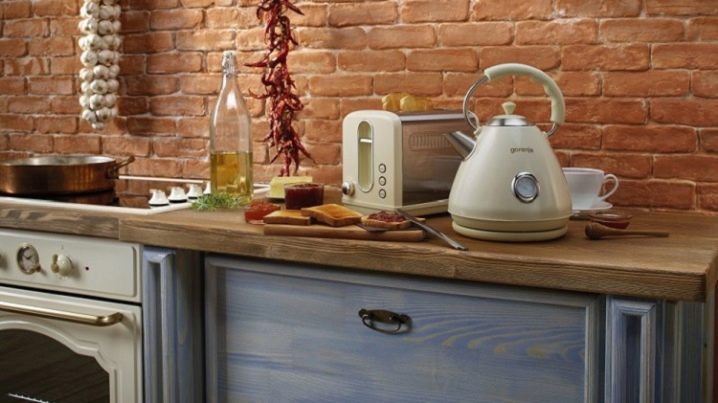
Wiring requirements
Let's talk about what parameters the wiring for the oven and, in general, the indicated types of equipment should correspond to. Consideration should be given to the factors and characteristics that the wire should have.
- Both devices must be connected to ground. The socket or plug must have 3 or 5 contacts, depending on the voltage in the mains. In old buildings, such conditions were rarely observed, but in new ones they try to comply with these requirements and immediately lay powerful cables.
- The wiring must be connected to the switchgear only using a special residual current device - RCD.
- Equipment that does not have very high power (up to 2.5 kW) must be connected to the existing electrical network, if it fully complies with modern standards. If you need to connect high-power built-in appliances, you will need to make a whole dedicated line.
- The best wire cross-section that can be used in this case is 6 square millimeters. This option can easily withstand a load of 10 kW for quite a long time. The recommended indicator of automatic protection in this case is C32. If the power of such a panel is not higher than 8 kW, then you can take a wire with a 4 mm cross-section and a C25 circuit breaker protection group.
- The best cable option that you can use is NYM or VVGng. When buying such a wire, the conductor diameter should be taken into account. If the wire has a cross section of 4 millimeters, then the diameter will be 2.2 millimeters, and the 6 mm wire will be 2.76 mm.
- The characteristics of the RCD should be slightly higher than the auto-protection rating by at least 1 point. For the 32 amp option, you will need to use a 40 amp RCD.
It should be said that then grounding must be available, it should not be neglected.



Place of installation
If your friends or acquaintances have presented you with such an equipment that has a separate power supply, then you need a combined power outlet. Such a double socket will allow connecting two devices at once and will become a single power source for this entire system. And such a contact will be of high quality and, if necessary, it will be possible to implement a quick connector. That is the hob for cooking is connected to a large outlet, and the oven is connected to a small outlet.

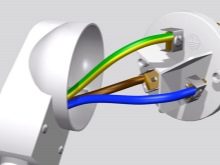
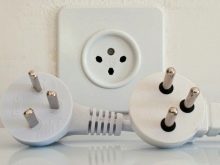
It is necessary to decide where we will put the outlet. If, for example, there is a place behind the furniture to the left or right of the oven, then you can install the socket there. There are no strict rules. Although an important point according to the European standard, the socket cannot be installed lower than 15 centimeters from the floor. But more often the outlet is placed at a distance of 16-25 centimeters from the floor, everything here will depend on each specific case, the goals and conditions that are available.

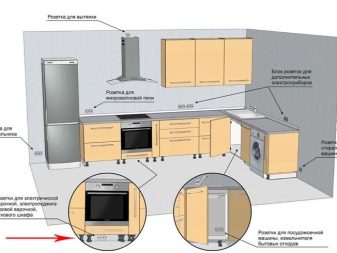
One more point - an outlet of this type is usually made on an invoice. That is, it does not enter the wall, but as if superimposed on top of it. But this moment should not scare anyone.The socket is connected to the electrical network using the hole located on the side.
Therefore, if you need or don't want to break the wall and lay the wire, you can simply connect the cable from the shield along the wall and fix it with special dowel-clamps. Or you can simply drown the wire in the strobe.


Connection diagram
Now let's talk about how the technology of interest to us is connected to the power supply. It is possible to apply one of two schemes for connecting equipment:
- single-phase;
- two or three phase.
The first option is carried out when installing equipment in rooms where there is only a 1-phase network with a voltage of 220 volts. The second case will be used to increase the power and efficiency of the technique. It is rarely possible to immediately determine the scheme, which is why the same hobs are not equipped with standard electric plugs.
If we talk about ovens, then they may have enough voltage of 220 volts, that is, a single-phase solution. Therefore, such options are equipped with a conventional Euro plug, which provides grounding contacts in its own design.
This solution is suitable for ovens where the rated current value will not exceed 16 amperes.


A single-phase connection is made using a three-core cable, which includes grounding, neutral and phase conductors. If you need to connect a hob for cooking in an old house, then the line there is usually made of aluminum, for which reason it needs to be replaced. To connect the types of equipment we are interested in to the outlet, you will need power version with a rated current with a value of 32 amperes. This double socket must be grounded.
When connecting the burners to the electrical panel, it is necessary to use one line, which will have its own separate auto-fuse. For equipment where the rated current will not be higher than 16 amperes, you can use a 25 ampere circuit breaker, and for 32-ampere type solutions - 40 amperes. There must also be a protective type grounding. Usually, in both versions of the devices under consideration, there is one grounding conductor, which has a green-yellow insulation, and it is connected to the body of the device and brought out to the required contact on the plug.
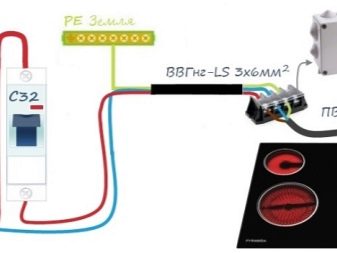
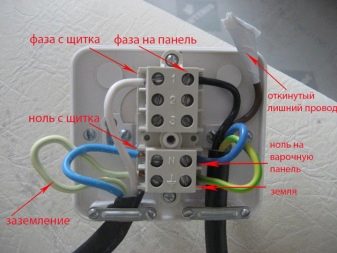
If the phase conductor is quite easy to determine using a simple indicator-type screwdriver, then it can be more difficult to distinguish zero from ground. Better to use a tester. The definition of all three types of cables is as follows.
- Where the socket will be installed, which is intended to connect the necessary equipment, using an indicator-type screwdriver, the phase should be determined. After that, it should be signed or marked.
- On the electrical panel, where the outlet will be connected, the purpose of each cable should be determined, which goes to the consumer. Neutral and phase wires can be easily determined using the same indicator screwdriver. If we talk about grounding, then it is connected to the electrical panel housing or to a special terminal box.
- Disconnect zero and phase from the input machine and connect.
- Now we determine with the help of a tester the resistance between the phase and the rest of the cables. Where the value is the smallest, there will be a null cable.
- When we have identified all the ends of the cables, it remains to install the socket and connect the drive to the auto-fuse.
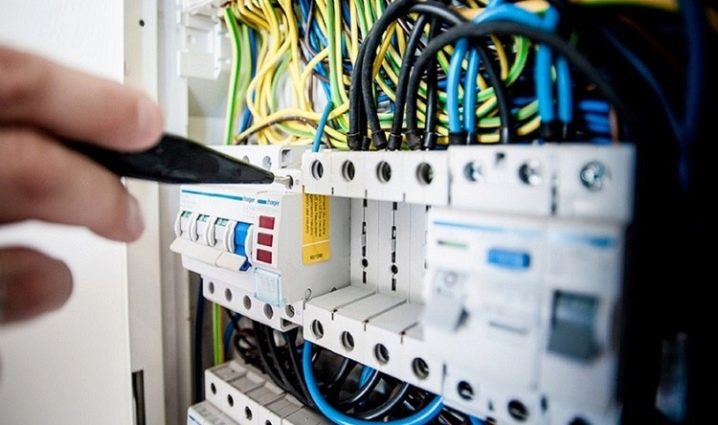
Now about the connection itself. If a single-phase version of 220 volts is implemented, then:
- the phase wire is connected to terminals L1-3, between which it is necessary to put several jumpers made of copper;
- the zero cable is connected to terminals N1-2;
- the ground goes to the terminal with the remaining designation.
If a three-phase version of 380 volts is implemented, then this is done so that the phases marked A, B, C go to the terminals with numbers L1-3. The remaining terminals are connected as described above.
In this case, there is no need to use jumpers.


If the connection is carried out in a 2-phase 380 volt circuit, then it should be said that this option is not common. It so happens that A and C are there, but there will be no third cable. The connection will be made in such a way that phase A will connect to L1-2 with a jumper, and phase C will go to L3. All other actions will be done as in other schemes.
Another option to consider is connecting the panel without a plug. When the outlet moves away from the wall a couple of centimeters, this does not suit the owners of the premises. You can solve the issue if you hide the parts of the outlet that protrude. This is done in one of two ways:
- using a special mounting box;
- with tinned copper sleeves.

You must first decide on the conductors. On some models, an already connected wire consisting of four cores is removed from the panel. But in some cases, there is only a 3-wire version. Such solutions will be designed for a 1-phase connection at 220 volts or for a 2-phase connection at 380 volts. That is, some of the equipment will receive energy from one phase, and some from the other. Moreover, the power will be distributed equally across them. To connect according to the 220 volt option, one of the cores must be insulated.
Now it remains to connect zero, ground and phase. If desired, the two phases can be connected in one through the tip. In some cases, there is a technique that has a cable consisting of 5 cores. These solutions are very powerful and are designed to be connected to 380 volts. To connect the panel to a 220-volt mains, two wires must be connected in pairs. For example, brown and black cables go to phase, and blue and gray wires go to zero. The earth must remain solitary.

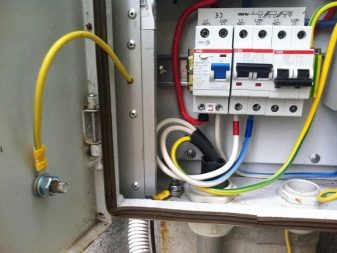
Possible mistakes
One of the most common mistakes is that the panel is connected by itself, but it can turn on and off on its own. This will be the result of an incorrect installation. This problem may be due to:
- active protection from children;
- ingress of moisture on the sensor elements of the equipment;
- accidentally pressing the wrong key.



Some models have a special function for recognizing dishes, so until there is a frying pan or pots on the panel, the equipment will not start working. Another problem is that only 2 of the 4 cooking zones are working. This situation may arise due to blocking, which appears when 3-phase models are connected in a single-phase way.
The blocking is done programmatically, so before looking at the connection features, you should read the instructions for the equipment. As you can see, it is not so difficult to connect the hob and oven to the outlet with your own hands.
The main thing is to know the basic rules for working with electrical appliances and to understand a little about their connection diagrams.

For information on how to connect the hob to the mains, see the following video.













The comment was sent successfully.